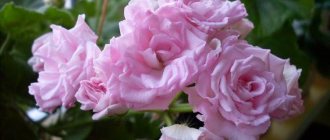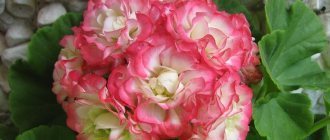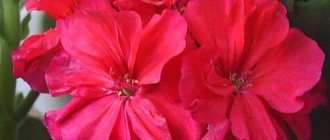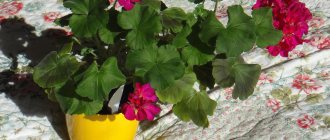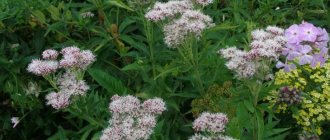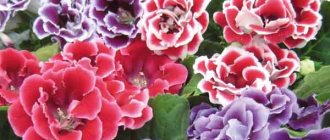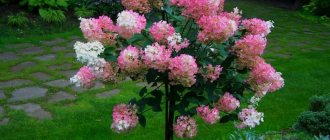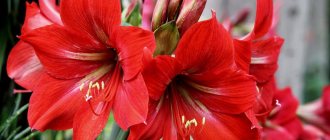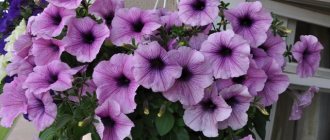Indoor geraniums growing on window sills, loggias and balconies, as in the photo, can look like herbaceous or semi-shrub plants with erect or flowing stems. All geraniums are highly decorative. Attention is attracted not only by simple or double flowers of all shapes and colors, but also by the unique leaves of the plant.
They can be wide, almost round, figuratively cut, finger-shaped, smooth corrugated, green and variegated.
The long-standing popularity of indoor geraniums as spectacular and unpretentious plants has led to the fact that over the last hundred years:
- a great variety of pelargonium varietal forms were obtained;
- wild species have been discovered and cultivated;
- interspecific hybrids appeared.
Therefore, the modern classification of the genus presents plant lovers with about 250 independent species, and the gradation of varieties of indoor plants, accepted in the international community of gardeners, suggests using its own designations based on external characteristics, as in the photo, of varieties and types of indoor geraniums:
- Stellar – star-shaped indoor geraniums, their varieties and hybrids;
- Tulip – tulip-shaped pelargoniums;
- Unique – indoor unique geraniums;
- Zonal - zonal or bordered domestic varieties of pelargonium.
- Angel – indoor geraniums angels;
- Colored Foliage – variegated varieties;
- Cactus – cactus-like pelargoniums;
- Ivy-leaved - ivy-leaved geraniums that can be standard sizes, as well as dwarfs and miniatures;
- Miniature and Dwarf – miniature and dwarf plants of indoor pelargoniums;
- Regal – royal geraniums;
- Scented-leaved – scented geraniums.
Features of growing ivy-leaved geraniums and care at home
Pelargonium is the same as geranium, so soil mixtures for flowering indoor plants are suitable for it. You can also find a special mixture for pelargoniums in stores. It is advisable to use a light loamy soil mixture for this plant. It should contain a lot of potassium, but there should be a minimal amount of nitrogen. The fact is that ivy-shaped (creeping) ampelous geranium, with an abundance of nitrogen, forms a lot of green leaves, but blooms much worse.
Watering should be moderate. This plant tolerates dry air well. It is clear that if it rains and the geranium grows behind the balcony in a special box, it does not need to be watered for several days after that. This flower will easily survive an insufficient amount of moisture in the air or soil. Things are much worse with excess moisture. It can easily lead to rot, and then the entire bush will disappear.
Pelargonium ivy-leaved terry variety
Pelargonium zonal or bordered (Pelargonium zonale)
All kinds of hybrids and varieties of this type of indoor geranium, as in the photo, grow well in the house, on balconies and even in city flower beds. This is the undoubted leader in popularity and number of cultivated varieties, of which there are about 75 thousand today.
Among other domestic perennial geraniums, zonal plants are easily recognized by the characteristic color of their foliage. Against a bright green background, darker areas are clearly visible, which give the name to the whole type of indoor geraniums, as in the photo. Zonal pelargonium flowers can be either simple or double.
When describing geranium varieties, in the photo, and in the names of plants, the following gradation is used according to the number of petals in the corolla:
- non-double flowers consist of five petals - Single;
- semi-double flowers have from 6 to 9 petals and are designated Semi-Double;
- double geranium flowers consist of 8 or more petals - Double.
Terry varieties are sometimes called peony geraniums, which is somewhat incorrect. There is no such group of plants in the internationally recognized classification.
Zonal geranium flowers differ not only in splendor and size. Long gone are the days when only red geraniums were displayed on the windows.
Depending on the variety and variety, pelargonium pleases the eye with umbrella-shaped inflorescences of all shades of pink, cream, burgundy or crimson. It is not uncommon to have plants with white, multi-colored and even yellow corollas, as in the photo of a geranium variety called First Yellow Improved.
Rosaceae (Rose-bud Zonal pelargoniums)
An example is a pink-shaped geranium, as in the photo, with double, showy flowers, reminiscent in structure and appearance of miniature English roses.
This variety of indoor geranium, its name and photo of flowers have been known in the world since the century before last. The first information about plants was published in the Bulletin of the Royal Horticultural Society of Britain in 1876. But in our country, rosaceous varieties have not yet become widespread and are found only in the collections of the most enthusiastic flower growers.
Tulip-shaped indoor geraniums (Tulipe-bud pelargonium)
A century later, flower growers received domestic geranium plants with flowers that, even in full bloom, do not open, remaining in the bud stage.
As a result, this indoor geranium shown in the photo was called tulip-shaped. The variety began with a spontaneous mutation, and the few varieties and hybrids of tulip-shaped geranium that exist today sometimes try to return to their natural form when grown or propagated.
Star indoor geraniums (Stellar Zonal Pelargonium)
Because of the sharp-angled, narrowed petals, the indoor geranium, in the photo, is called star-shaped.
Currently, flower growers have at their disposal varieties and hybrids not only with simple and double flowers of all shades, but also star-shaped pelargoniums with bright multi-colored foliage.
Cactus-shaped house geraniums (Cactus Pelargonium)
Carnation Pelargonium
Features of the view
A variegated variety of pelargonium appeared in the 19th century after the revolutionary discovery of the mosaic gene by E. Bauer. This discovery gave impetus to breeding work to develop various plant varieties. Professionals and amateurs continue to work to this day, so it is very difficult to count the exact number of varieties.
The highlight of variegated geranium is its unusual leaves, which differ in the number of colors in which the leaves are painted. Geraniums come in three-color and two-color varieties, painted in all sorts of shades of green, cream, and purple. This variety is divided into subgroups not only according to the number of flowers on the leaves, but also by color: golden yellow and silver; according to the pattern of the dark zone - a butterfly.
Royal, fragrant and ivy-leaved geraniums also have variegated representatives among their varieties, but most of them are among the zonal varieties. You can choose a variegated leaf by size: standard, dwarf or miniature. And in terms of the shape of the flower, there are no limits to the imagination.
Most popular varieties
Several species of ivy-leaved pelargonium have now been selected. Among them, gardeners give preference to several varieties because of their decorative properties.
Angel
This plant is not too tall. It can grow up to 30 centimeters in height. Outwardly, it looks like a pansy. Flower growers often grow it at home. This variety is quite hardy compared to others. and it is not difficult to care for. To make the composition look more decorative, you can plant several flowers at once in one container. So, the bushes look more lush.
Tuscany Eva
This variety of flower is most loved by gardeners because of its short growth and beautiful snow-white flowers. The height of the bush reaches half a meter. It begins to bloom in May and pleases its owner with flowering until the frost.
Tornado
This variety is the result of the work of Dutch breeders. Bushes of the "Tornado" variety are low, about 30 centimeters. Bright red buds bloom on it. In gardens and apartments it can be seen growing in flowerpots and hanging baskets.
PAC Pink Sybil
This variety is valued for its double pink inflorescences. Externally, such pelargonium can be mistaken for a decorative rose. PAC Pink Sybil blooms early, but its flowering period itself is long.
PAC Sally
This species is characterized by lush flowering. The plant has a large number of dark burgundy flowers with a terry surface on the bushes. Inflorescences can merge into entire caps of flowers.
Toscana Josina
Characteristic features of the variety: double flowers with a rich lilac hue and an abundance of small two-color leaves.
Toscana Okka
The plants will delight their owner with bright orange flowers collected in inflorescences. On the petals of Toscana Okka flowers. as if painted, white stripes.
Toscana Malaika
This is an early blooming pelargonium variety with purple-pink inflorescences. The Toscana Malaika bush blooms profusely. No less popular for breeding and growing are the varieties “Amethyst” or “Rhapsody”.
The best varieties
Beginning gardeners are recommended to choose varieties with golden or bronze-black leaves: they are not capricious, hardy, less demanding in care, are not afraid of direct sunlight and tolerate winter well. Bridesmaid, Burns Country, and Golden Choice varieties are perfect. The following varieties are especially popular among amateurs and experienced gardeners:
- Wilhelm Langguth. Standard variety with dark green leaves. Bright sunlight does not harm the leaves, they just become darker. The bush is formed without difficulty, the leaves practically do not dry out. Unpretentious, does not require special care. The flowering is lush, the inflorescences are bright, with a terry foliage structure;
- Chelsea Gem. A very delicate unusual flower with white flowers and leaves with a light pink dusting. The bush itself is low and compact;
- Frank Hazel. A variety that has somewhat lost popularity compared to new varieties. However, lovers of aesthetic simplicity combined with ease of care will certainly appreciate this variety. In addition, he is not afraid of weather troubles and heat. The creamy green color of the leaves harmonizes perfectly with the bright salmon-colored flowers;
- Priory Coral. Dark pink fluffy flowers go perfectly with white and green leaves.
Appearance
The main distinguishing feature of this variety of pelargonium is its graceful, unevenly colored leaves. It is because of the foliage, and not because of the flowers, that in this case the plant is bred. The following shades predominate in foliage color :
- green;
- emerald;
- burgundy;
- purple;
- plum;
- bronze.
According to the color of the foliage, variegated pelargoniums are divided into two subgroups:
- yellow-golden , in which the main color of the leaves is yellow;
- silver , in which the main color can be any, but there is one distinctive feature - a cream-colored canvas around the edge.
The predominant pattern on the leaves is a butterfly, and it is always darker than the main shade. The number of shades mixed in one sheet is usually two, sometimes three.
Appearance Features
The variety is distinguished by its most beautiful variegated foliage: the bright green center is often surrounded by a white and yellow border, revealing a burgundy tint in the sun. In addition, the foliage has a border of two or three stripes, highlighted on the leaf with cream, yellow, brown, and golden colors. The inflorescences are small, simple in shape with bright flowers.
The genus stands out for its calm growth and good branching, and is wonderfully suitable as a detail in the interior due to its unique decorative leaves.
Attention! The most unpretentious geraniums are considered to be varieties with golden and gold-black leaves. They are considered the most hardy, they tolerate wintering and direct sunlight well.
Description of the plant
Ivy-leaved geranium is also called creeping geranium, which in itself reflects the characteristics of this plant. The stems of this variety are ampelous, the leaves are similar to ivy not only in shape. They have a smooth surface with a light, subtle shine. Geranium of this species has quite powerful shoots. In most varieties they can reach 1 m in length. At the same time, the shoots cling well to any protrusions on vertical surfaces, quickly rise upward, and later, after flowering, they can scatter seeds around.
Pink and white ivy-leaved pelargoniums
This variety also has elongated peduncles. They are characterized by umbrella inflorescences, uniting 10-15 relatively small flowers. The buds of this variety of geranium are bright. But the flowers of most varieties are already lighter in color. Although there are both dark purple and scarlet varieties, white-pink and lilac varieties predominate.
Advantages and disadvantages of ivy-leaved pelargonium
Ivy geranium is popular with many gardeners due to the following advantages:
- the presence of a large number of varieties with varied shapes and colors of flowers. There are also variegated varieties that look attractive even when they fade;
- ease of cultivation, since this is a very undemanding plant that even a novice gardener can handle;
- abundant flowering;
- Most varieties take root well in both soil and water.
As for the disadvantages, this variety of geranium has practically none, with the exception of one. Pelargonium ivy is difficult to overwinter in an ordinary city apartment. But this is a solvable problem; experienced flower growers advise in such cases to use additional ultraviolet lamps for lighting.
Origin
ATTENTION : For the first time, variegated pelargonium was introduced to a wide range of flower lovers already in the 19th century, and today the plant is one of the favorites of flower growers around the world. In 1909, the scientist E. Bauer discovered the mosaic gene - that’s when systematic selection and breeding of various varieties of these amazing plants began.
Let us note that breeding work in this direction is still being carried out , and botanists, both professionals and amateurs, do not tire of presenting new varieties of this species. The cost of the plant depends on the variety - you can purchase a rooted cutting for either 300 or 700 rubles.
Such varieties as Barnes Country, Golden Shock, Bridesmaid deserve special attention: they are all distinguished by graceful leaves of unusual black and gold (yellow) colors. In addition to their exceptional decorative properties, the listed varieties are also quite easy to care for, so they are ideal for beginning gardeners.
Where is the best place to plant and how?
Ideal soil
You can plant them in ready-made store-bought mixtures with neutral soil acidity.
If you don’t trust store-bought ingredients, you can prepare the mixture at home. You will need two parts:
- turf land;
- sheet;
- distillation.
All this needs to be mixed with a small amount of coarse sand. Drainage and a thin layer of soil are poured into the pot, on which the flower is planted along with the soil, sprinkling the roots with new soil.
During budding, it is necessary to intensively fertilize the transplanted flower . Using complex feeding once a week will be sufficient. Compost can be combined with irrigation by diluting it with water. Such a tandem will ensure access of nutrients to the roots. It should be replanted in early spring.
Location and lighting
Experienced flower growers advise placing the beauty near a south window.
When growing pelargonium on the balcony, you can transfer it there in April. If you want to send a flower to the garden, wait until the air and soil warm up to the proper temperature.
During the cold period, place geraniums on the warmest and brightest windowsills . She is not afraid of sunlight. Increased lighting is good for her. But on the days of the warm season, leaving the geranium on the window, it is necessary to shade the crop from the rays.
Care
For active growth and long-term flowering of the bush, you need to properly care for it. Growing ampelous pelargonium differs from geranium.
Light
This is one of the crops that is not afraid of the sun and burns. Ampelous pelargonium prefers an abundance of light, which is necessary for the development of the plant. It is not recommended to place the pot with it on the north window. It can only fully bloom on the south side. If this is not possible, then the flower needs to be illuminated with artificial light.
Temperature
On hot days, the temperature in the house should not rise above 32 degrees, otherwise the bush will simply burn. In winter, the air should warm up to at least 15 degrees. But even at this temperature, the bush can continue to bloom.
Watering and spraying
The plant is not afraid of dry air in the room, it does not need to be sprayed, but on hot days it needs to be watered every day. But at the same time, the flower has an extremely negative attitude towards flooding with water. Its leaves quickly rot when moisture accumulates. To prevent this from happening, water it at the root so that water does not flood the plant.
Overflows of water are worse for her than dry soil. In summer, the plant is watered a little every day. But if the soil at a depth of three centimeters has not had time to dry since the last watering, then watering must be rescheduled; even on the hottest days, the bush is not sprayed.
In winter, watering is reduced and depends on the temperature in the room. Watering once a week in winter is usually sufficient.
Priming
The best substrate for an ampel would be loose soil with an abundance of nutrients. To prepare it, you should take sand, peat and turf in equal parts, and thoroughly mix the ingredients together.
Such soil retains water and does not allow it to stagnate in the root area. When growing a house, a drainage layer must be laid out at the bottom of the container. The container for the ampel should be such that the stems can hang freely. Typically, flowerpots or pots placed on balconies are used for these purposes.
Fertilizer
It is necessary to feed the climbing plant during the entire flowering period. It is recommended to fertilize the bushes once every seven days, enriching the soil with humus or mineral compounds. The rest of the time, the amount of fertilizing is reduced and the flower is fed approximately once every 20 days. In spring and summer, the plant should be fed with compounds containing potassium and phosphorus. At other times of the year, the soil should be enriched with organic fertilizers and humus.
An alternative fertilizer can be “milk water”. Milk is simply diluted with water in a ratio of one to two. This solution saturates the leaves and other parts of the plant with nutrients.
Bush formation
To ensure that the bush always remains lush and dense, it should be pruned. It is best to do this in the spring, when the plant has just “woke up”. It is necessary to cut off all branches, except those that have two to four nodes.
Cutting is done only with a knife. You cannot pick them with your hands or break them off, because the flower quickly begins to rot. In case of severe injury to the plant during pruning, the “wounds” must be treated with crushed charcoal. As a result of the procedure, the base of the cutting should remain on the bush, and not on the cut leaf. Pruning and shaping the bush allows you to give ivy-leaved pelargonium the desired shape and remove diseased branches.
Features of care
- Trimming.
- Watering.
- Temperature.
The right time for the formation of variegated geraniums is spring . Autumn circumcision is poorly tolerated. Thanks to this procedure, wintering can be facilitated, the appearance of young shoots and lateral shoots can be formed, and the number of inflorescences can be increased. The plant that has grown during sleep is pruned again in the spring.
Important! From mid-autumn, geraniums begin a dormant period and development stops.
On hot days, constant watering is necessary, but it is important to ensure that the water does not stagnate. Pots must have drainage holes; they help drain excess water. Spraying and washing the leaves is strictly prohibited; this harms the plant. Water should be at the root or in a tray.
Do not forget that geraniums need winter rest . The suitable temperature for this is 10°C. If you do not maintain the correct temperature during this period, you may not expect buds. If you find a darkened edge of a leaf in winter, immediately remove it from the window, this is a warning that the temperature is too low.
During the flowering period, the temperature is approximately 20-23 degrees. In free outdoor space he feels comfortable even in the sun.
Landing rules
Let's find out the main points regarding the proper rooting of variegated pelargonium.
Choosing a location and lighting
Variegated pelargonium prefers sunny, well-lit windowsills and areas at any time of the day. The decorative variegation of the leaves of the plant manifests itself most effectively in good lighting. With the right type of lighting, pelargonium is able to maximize its decorative effect .
It is important to shade the plant from too active sunlight. This recommendation especially applies to varieties with light centers of leaves. Overheating is extremely undesirable for this flower. If the temperature is too high, variegated pelargonium grows poorly, gets sick, and is more often affected by pests.
The soil
In order for variegated pelargonium to develop safely, it needs to be kept in a special soil mixture: below we will tell you how to prepare the substrate. So, the recommended soil composition for variegated pelargonium :
- 2 parts of turf;
- 1 part humus;
- 1 part leaf humus;
- 1 part peat;
- 1 part river sand.
Propagation by cuttings
Ivy-leaved geranium, that is, ampelous, is most often propagated by stem cuttings. It is best to carry out this procedure in August-September. The average length of a stem cutting suitable for propagation should be 5-15 cm.
Cuttings should be separated from the mother bush with a sharp knife. You cannot tear them off, as this can damage the plant. The trimmings obtained in this way are left for a day, waiting for the sections to dry properly. Then, for disinfection purposes, they are treated using activated carbon (although it is better to use charcoal).
To root the cuttings, it is recommended to pre-heat the soil in the oven to prevent infection or pests from getting there. The cuttings are planted at a distance of 2 cm from each other.
Reproduction
- By cuttings.
- Dividing the bush.
We prepare the cuttings by drying them in a container containing coarse sand and perlite. Planted branches are placed in partial shade for adoption . As soon as the plant has strengthened, it can be safely planted in containers and placed in a normally lit place.
To divide the bush, you need to water it well, then pull it out of the pot with a lump and carefully divide it. After dividing, trim tall branches to 5-7cm and plant in the ground. At first, the plant will be capricious, dropping leaves and withering - this is normal. After a week, feed the future flower a little to stimulate growth.
By learning how to properly care for a plant, you can grow an incredibly beautiful flower that will definitely reward you, delighting you with its colors and bizarre shapes.
Care
Let's take a closer look at the main features of caring for this ornamental plant.
Watering
Unlike other types of pelargonium, variegated pelargonium does not need abundant watering .
In this case, soil moisture should be moderate even in summer, not to mention winter. The main signal that it is time to water pelargonium is the dried top layer of soil. It is not recommended to spray the plant, as drops of water can spoil the decorative appearance of the foliage and lead to burns and rot. Water, trying to “aim” directly at the root. The water should be at room temperature, soft and settled.
If water gets on the leaves of the plant during the procedure, then dry them in a warm, shady place. To allow air to flow freely to the roots, it is recommended to loosen the soil after watering . And if you notice that unsightly brown spots begin to appear on the variegated leaves, it means that watering is not carried out correctly.
Transfer
In spring, it is recommended to replant pelargonium in fresh soil. After the plant has successfully settled into the new substrate, prune it - this way the pelargonium will be completely ready for the new growing season.
Trimming
The bush needs shaping . It is especially important to regularly cut off completely green shoots, as they spoil the shape of the bush and absorb nutrients. If, over the winter, the plant has formed thin, weak, elongated shoots, they must be cut back by a third.
Top dressing
Variegated pelargonium responds gratefully to fertilizing and needs additional nutrition throughout the active growing season - from spring to autumn. In winter, the plant is not fed, since at this time pelargonium goes through a “rest period”.
In spring and summer, the flower is supplied with additional nutrition twice a month. In order for a plant to grow and develop safely, it must be provided with three main minerals: phosphorus, potassium, and nitrogen.
It is recommended to purchase ready-made complex compositions for pelargoniums , where all the ingredients are taken into account in the required quantities.
Suitable for variegated pelargonium, in addition to standard ones, are such compositions as Agricola, Kemira. If you fertilize in combination with regular watering, then use 2-3 times less fertilizer than with regular fertilizing. If you decide to feed the plant with your own mixtures, then keep in mind that all of the listed components must be taken in equal proportions. However, before pelargonium blooms, the proportion of nitrogen should be reduced and potassium increased.
Wintering
In winter, variegated pelargonium must rest: all its vegetation processes slow down, we can say that the plant “hibernates”. The temperature in the room where the flower is kept in winter should not exceed +15 degrees - otherwise the plant will not be able to fully rest. Watering is reduced to once a day, and it is recommended to stop fertilizing altogether for the winter .
Secrets of care
The first thing to remember: variegated pelargonium does not need frequent and abundant watering. Moderate summer watering is reduced even further in winter. Check the soil: if the top layer of soil is dry, you can water it. It is generally not recommended to spray the flower. Drops of water can damage or burn the leaves, as a result of which its decorative appearance will deteriorate. It is best to water gently directly at the root, without touching either the leaves or the stem. The water should be settled and at room temperature. Excess moisture on the sheets must be dried.
The appearance of brown spots indicates a violation of the watering regime. Periodically, the soil in the pot needs to be loosened so that air flows freely and moisture is not retained. In spring, the flower is replanted and pruned. After the plant adapts to the new soil, it is pruned to give shape and cut off excess green shoots, which draw out nutrients and prevent the bush from blooming. Before the dormant period, thin and weak shoots are cut off or shortened.
During the active growing season and flowering phase, geraniums need to be fed twice a month. Fertilizer complexes specially designed for pelargoniums are ideal; they contain in optimal proportions all the nutrients necessary for the flower, including potassium, phosphorus and nitrogen.
Such fertilizers are applied strictly according to the instructions, preferably with watering. However, when watering, the amount of fertilizing should be reduced several times. It is also quite possible to prepare fertilizers yourself. You just need to remember that you need to combine them in equal parts, and before flowering, reduce the nitrogen content and increase the potassium content. In winter, you cannot feed the plant.
The temperature must be reduced to 14–15 °C so that the plant can fully rest. Poor care can cause diseases, in particular fungal infections. The bush is especially often affected by gray, root and stem rot. Root rot automatically means the death of the plant; you can try to cope with other types using fungicides and removing all affected parts. The flower should be treated with insecticides against pests.
Variegated geraniums are propagated, like other species, mainly by cuttings in late summer or early autumn. The cut is treated with a growth stimulator and charcoal and placed in a peat tablet. After rooting, they are planted.
Choose your variegated one and your home will sparkle with new colors.
Pelargonium (geranium): 70 photos
The beautiful appearance of pelargonium and its regular flowering depends not only on watering and feeding, but also on regular pruning. At the same time, a new plant can be grown from the cuttings obtained.
It is recommended to carry out cuttings no more often than once every two years, so that the geranium has time to grow and develop. If the bush is small and weak, then once every three years. Cuttings can be taken at any time, including winter. If you do this in early spring, you can already see the first flowers in the summer.
Spring is also ideal for propagation because at this time all processes of growth and development are especially intense, which means that the cuttings take root faster and stronger. But this is only a recommendation, not a mandatory rule. Pelargonium tolerates cuttings well in any season. Perhaps you will be able to admire the first results next year.
To propagate pelargonium by cuttings, you need to take into account the following nuances:
- For dwarf varieties, the cutting length is up to 2.5 cm, for ordinary varieties - 5 cm;
— You can root the shoots in water or in the ground. To be on the safe side, use special means to improve rooting, which are used for processing cuts, but this is not necessary;
— For planting you will need pots with pallets, suitable soil mixture and sand;
— Choose a top with three or more leaves;
— It’s better not to cut branches with buds. If there are buds, it is advisable to remove them so that they do not draw resources onto themselves. A young plant will still not allow them to open;
— Cut the cuttings only with a sharp knife at a right angle. The cut cuttings need to be dried for several hours so that the cut is covered with a film. In the future, this will protect against rotting;
— Cuttings are planted in drained pots with holes. About a third of sand is added to the soil;
— To disinfect the soil, it is enough to treat it with boiling water or a weak solution of potassium permanganate;
— The cuttings go several centimeters into the soil. The earth needs to be slightly compacted so that the shoots do not fall;
— For the first days, keep the pots in the shade, but by the end of the week they can be moved to the sun and watered abundantly. Pour water not into the ground, but into a pan;
— Try not to wet the pelargonium leaves. This can cause them to become stained or even rot;
— The average duration of the rooting process of shoots is 2–6 weeks, depending on the variety of geranium;
— If you choose to root the cuttings in water, place them in pre-settled water. You can replant the stems when the roots grow more than 2.5 cm. Plant pelargonium as delicately as possible so as not to damage the rhizome.
Diseases and pests
Let's get acquainted with the most dangerous diseases and harmful insects for variegated pelargonium.
Gray rot
This disease manifests itself as characteristic brown and grayish spots on the leaves of the plant. Then the foliage begins to dry out and wither, and if you do not pay attention to the disease in time, the entire plant will die. Usually the problem occurs due to waterlogging of pelargonium during the cold season . To stop the disease, the affected areas of the leaves should be cut off; in severe cases, clean shoots should be cut off, and the plant should be transplanted into a new pot with fresh soil.
Other rot
Types of rot such as root and stem rot can also affect variegated pelargonium.
The most common cause is overwatering. Root rot cannot be treated: in this case, the plant is disposed of. If the stem rot has not yet spread greatly and has not penetrated into the root system, you can still fight for the flower by carefully removing all the affected parts, then treating the pelargonium and soil with systemic fungicides. The drugs Biporam and Fitoflavin are best suited in this case .
As for pests, the danger for variegated pelargonium is mainly whitefly. To avoid the appearance of this pest, it is recommended to systematically spray pelargonium with insecticides.

